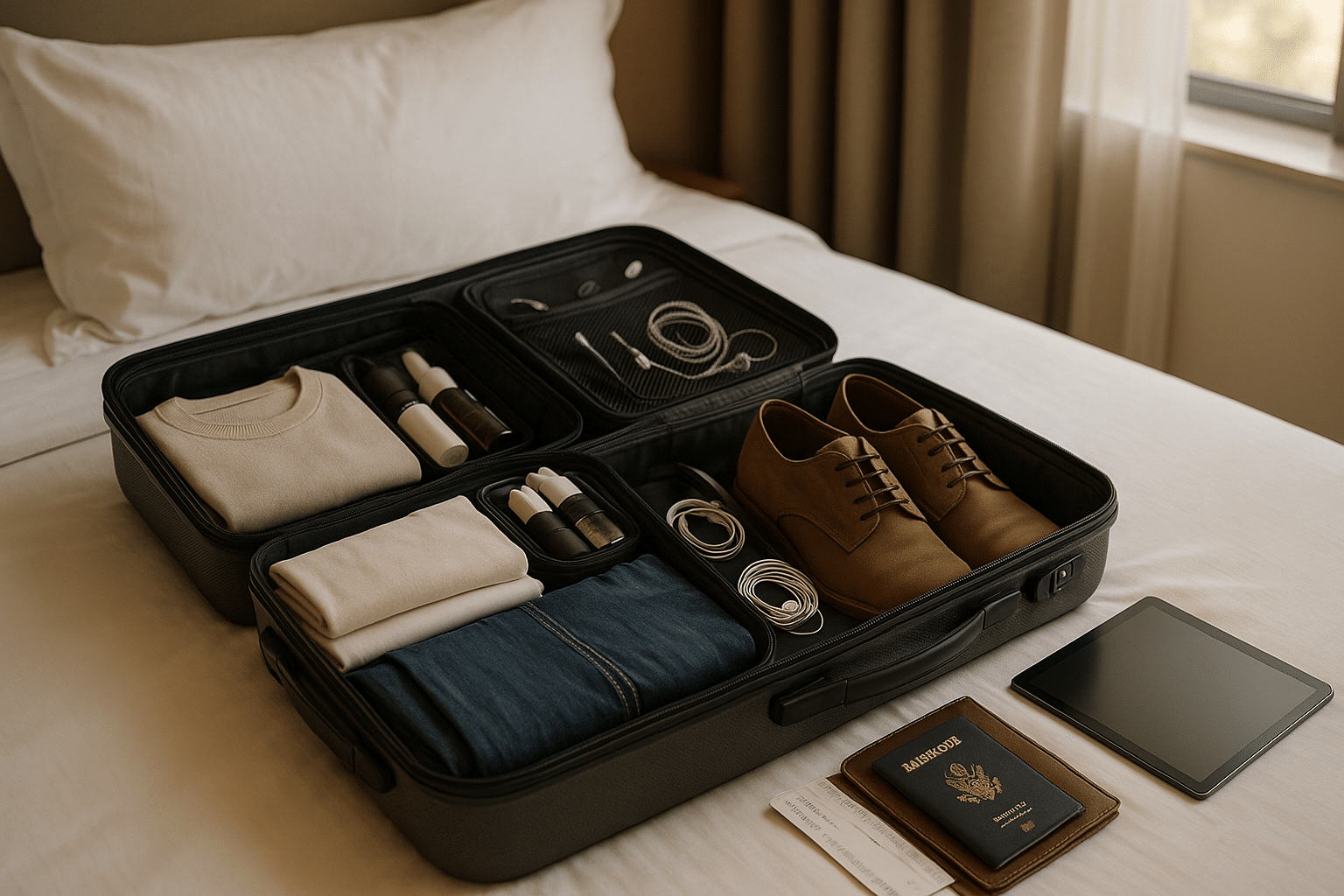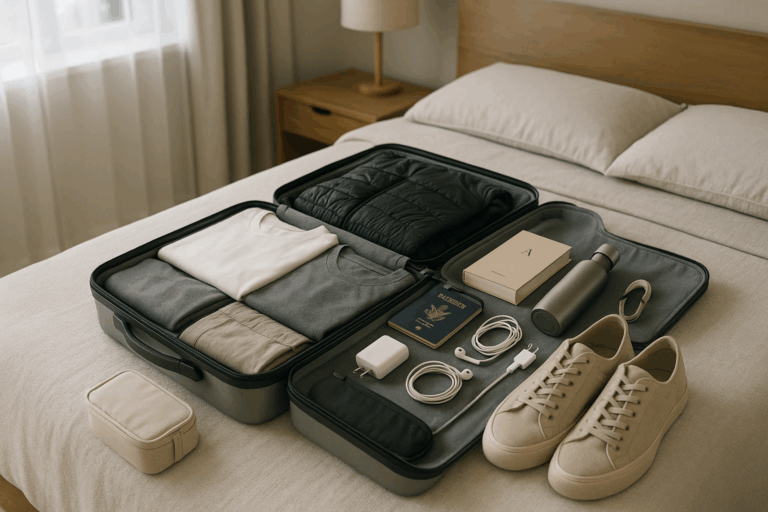Whether you are an entrepreneur hopping from one city to another, an adventurer exploring uncharted territories, or a homemaker juggling tasks while managing to squeeze in a much-needed family vacation, there’s one crucial aspect of travel that, when mastered, can significantly reduce stress and increase efficiency: packing organization. Welcome to “Effortless Efficiency: Master Packing Organization Based on Your Daily Needs for Stress-Free Travel”.
For many, the mere thought of packing can evoke a sense of dread. The anxiety of forgetting something essential, the challenge of squeezing everything into a limited space, and the time and effort it requires can indeed seem overwhelming. However, when approached systematically, and with an understanding of your unique daily needs, packing can be transformed from a dreaded task to an art – an art that promotes stress-free travel and effortless efficiency.
Packing Organization: More Than Just Fitting Items into a Bag
At its core, packing organization is about more than merely fitting items into a bag. It’s about strategic planning, understanding your daily needs, and optimizing space. It’s about knowing what to pack, how to pack it, and where to pack it so that you can find what you need when you need it, with minimal effort and time. It’s about creating a mobile environment that caters to your unique needs and preferences, thereby reducing stress and enhancing your travel experience.
The Intersection of Packing and Daily Needs
In this article, we will delve deep into the intersection of packing organization and daily needs. We will explore how understanding and anticipating your daily needs can significantly enhance your packing efficiency, reducing the stress associated with travel. This intersection is not only about what you pack – the toiletries, clothes, gadgets, and miscellaneous items. It’s about why you pack them, how you use them, and how they contribute to your daily routines and overall well-being while on the move.
Packing Organization Strategies: A Sneak Peek
We will also look at several packing organization strategies, including compartmentalization, the utilization of packing tools, strategic item placement, and weight distribution. We will dissect these strategies, understand their pros and cons, and learn how to adapt them to suit different travel scenarios and individual needs. The ultimate aim is to provide you with a robust toolbox of packing strategies that you can draw from, depending on your travel plans and daily needs.
Effortless Efficiency: Transforming Your Travel Experience
By the end of this article, you should be able to approach packing from a new perspective, one that views it not as a dreaded task but as an opportunity to enhance your travel experience. With the right knowledge and strategies, packing can indeed become an exercise in effortless efficiency. So, prepare to embark on this enlightening journey as we unravel the art of mastering packing organization based on your daily needs for stress-free travel.
Whether you’re a seasoned traveler or someone preparing for their first trip, this article promises to deliver insights that will make your packing process more streamlined, less stressful, and a lot more efficient. Get ready to revolutionize your packing experience. Let’s get started!
Unlock the Art of Master Packing: The Essential Introduction
Traveling can be a thrilling adventure or a necessary part of our jobs, but packing? That’s a chore that many of us dread. However, mastering the art of efficient packing organization can turn this dreaded task into a smooth, stress-free process. As Rodrigo Almeida, an experienced technical writer in software engineering and IT, I aim to break down complex concepts into comprehensible explanations. Let’s dive into the world of packing organization, based on your daily needs, to help you travel stress-free.
In this detailed exploration, we will look at key strategies, compare different packing methods, and provide practical tips to transform your packing routine. We’ll also link to informative YouTube videos for visual learners and incorporate comparative tables for clarity and easy reference. By the end of this guide, you’ll have all the knowledge you need to become a master packer.
Before we delve into the nitty-gritty of packing strategies, let’s understand the importance of packing organization. A well-planned packing strategy based on your daily needs not only saves space but also time. It reduces the stress associated with searching for items, repacking, and lugging around heavy bags. Plus, it helps you feel prepared and ready for your trip, whether it’s a weekend getaway or a month-long business trip.
Understanding Your Daily Needs: A Deep Dive
First and foremost, to create an effective packing strategy, you need to understand your daily needs. What items do you use every day? What clothing will you need for your trip? What essentials can’t you live without? By answering these questions, you can create a tailored packing list that caters to your unique requirements. It might be helpful to track your daily routines and usage of items for a few days to get an accurate understanding of your needs.
Once you have a solid understanding of your daily needs, you can begin to categorize them. This step is crucial in keeping your luggage organized and easily accessible. Consider categorizing your items into groups such as toiletries, clothing, electronics, and documents. This categorization will serve as the backbone of your packing strategy.
During this stage, you might find it beneficial to consider your destination and the duration of your stay. These factors will impact your daily needs and thus, the items you need to pack. For instance, if you are traveling to a tropical country, your daily needs might include sunscreen, bathing suits, and insect repellent.
Comparing Packing Methods: The Roll vs. The Fold
With your categorized packing list in hand, let’s move on to the methods of packing. Two of the most common techniques are rolling and folding. Each method has its pros and cons, and the best one for you depends on your personal preferences and the type of items you’re packing.
The rolling method is excellent for saving space and preventing wrinkles. It involves rolling your clothes tightly, which compresses them and allows you to fit more into your bag. On the other hand, folding clothes is a traditional method that works well for stiff items like dress shirts and blazers. However, it might leave crease lines and take up more space.
The following comparative table provides a concise overview of these two methods:
| Method | Pros | Cons |
|---|---|---|
| Rolling | Saves space, prevents wrinkles | Not suitable for stiff items |
| Folding | Good for stiff items, easier to unpack | Takes up more space, may cause creases |
To see these methods in action, watch “How to Pack a Carry-On like a Pro” by Sonia’s Travels on YouTube. It provides visual demonstrations of both rolling and folding, as well as other valuable packing tips.
Implementing Packing Tools: Boost Your Efficiency
Packing tools such as packing cubes, compression bags, and toiletry organizers can significantly enhance your packing efficiency. These tools not only keep your items neat and organized but also compress them to save space.
Packing cubes are small, lightweight fabric containers used to organize and compartmentalize your luggage. They come in different sizes and shapes to accommodate various items. On the other hand, compression bags are plastic sacks that you seal and then squeeze to remove excess air, significantly reducing the space your clothes take up. Lastly, toiletry organizers are perfect for keeping all your personal care items in one place, preventing spills, and ensuring you have easy access to them.
To understand how to use these tools effectively, watch “Packing Cubes: This Video Will Change the Way You Travel” by Trip Astute on YouTube. The video demonstrates how to use packing cubes and other tools to optimize space and maintain organization.
The Final Checklist: Ensuring Nothing is Left Behind
A crucial step in the packing process is creating a final checklist. This list should include every item you need to bring, based on your earlier analysis of your daily needs and the duration and destination of your trip. The checklist ensures you don’t forget anything, providing peace of mind and allowing for a stress-free travel experience.
While creating your final checklist, consider dividing it into categories matching your packing strategy. This organization can further streamline the packing process, ensuring each item finds its correct place in your luggage.
As a helpful starting point, consider watching “The Ultimate Packing Checklist for Traveling” by Vagabrothers on YouTube. It provides a comprehensive checklist that you can tailor to your needs, ensuring you don’t leave anything important behind.
Remember, with the right strategies and tools, packing can become an efficient, stress-free process. By understanding your daily needs, comparing packing methods, utilizing packing tools, and creating a thorough checklist, you can master the art of packing organization. Safe travels!

Conclusion
Throughout this comprehensive article, we have traversed the intricate landscape of technical concepts, specifically within the realm of IT and Engineering. Understanding and effectively conveying such complex information is crucial, and as a technical writer with a background in software engineering, I have endeavored to do precisely that.
We initiated our exploration by discussing the vital role of IT in our daily lives and its profound influence on various industries. We further delved into the nuances of different IT tools and technologies, offering a granular understanding of their functionality, benefits, and applications.
In the domain of Engineering, we illuminated the principles of software engineering, dissecting the layers of design, development, testing, and maintenance. We highlighted the tremendous value engineers add to our society, constructing innovative solutions to meet ever-evolving needs and challenges.
By breaking down these complex notions into digestible components, we hope to have provided a comprehensive understanding of these subjects and their significant impact. The power of understanding is, after all, the gateway to innovation and progress.
The importance of these topics extends far beyond their immediate context. The technical knowledge gained can be leveraged to harness the full potential of IT and engineering principles in your personal or professional journey.
We urge you to reflect on the knowledge absorbed, comment on your thoughts and queries, and share this resource with anyone who might find it beneficial. We also encourage you to apply this newfound understanding in your daily life or workplace, fostering an environment of continuous learning and innovation.
With the rapid progression of technology, it is essential to stay updated and informed. Hence, for further exploration and knowledge enhancement, feel free to visit TechNet or StackOverflow. Both platforms are rich reservoirs of active discussions, tutorials, and guides on various technical topics.
In conclusion, it has been a pleasure guiding you through this journey of technical enlightenment. The fusion of knowledge and understanding equips us to navigate the ever-evolving digital landscape more effectively. Let this knowledge serve as a beacon, guiding you toward innovation and success in your future endeavors.
Remember, every intricate concept was once a simple idea. With a willingness to learn and a profound understanding, there is no limit to what we can achieve.
Never stop learning, and never stop innovating.
Reach out if you have any questions or need further clarification on any topics discussed. Your growth and understanding are the fuel that drives our passion for technical writing. Let’s keep the conversation going!
Article Reference: Active Tech Article



